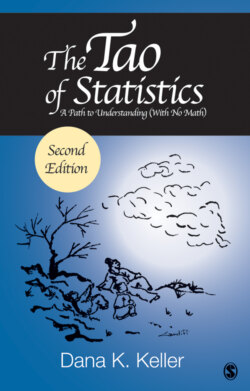Читать книгу The Tao of Statistics - Dana K. Keller - Страница 16
На сайте Литреса книга снята с продажи.
5.C. Interval
ОглавлениеInterval is regular
Same steps, no cracks
Yet zero is not none
Interval data have evenly spaced steps but no true zero. Course grades could be an example, where a zero score on a math test does not mean a complete lack of mathematics knowledge. A zero on a math test means that the student did not arrive at a single correct answer for the sample of possible relevant mathematics questions on the test, but the test has no way of capturing whether the student has no knowledge of the assessed topic. The zero is a measurement convenience.
Many statistics require interval levels of measurement (or could use ratio, discussed next) to yield valid results. Topics from grading differences in sections of the same course to the predicted flu infection rates for next year generally require this level of data. At a minimum, some reflection is appropriate when determining which statistics will be used with data.
For the high school principal, most student achievement measurements are used as though they were at an interval level of measurement, as discussed earlier. The very fact that the debate continues, more than a century since its inception, is testimony to the resiliency (what statisticians call “robustness”) of the mean to minor violations of its required level of measurement.
Many examples of the director of public health’s data are dichotomous (i.e., only two possible responses). For example, immunizations are coded for people in one of two ways, either yes (1) or no (0). These types of data generally can be used in statistical techniques that assume interval levels of measurement.
Examples of true interval data are somewhat rare. The most common are Fahrenheit and Celsius scales to measure temperature. In the end, the interval level of measurement is important to the proper selection, use, and interpretation of statistical methods, but it has few true examples in daily practice.
